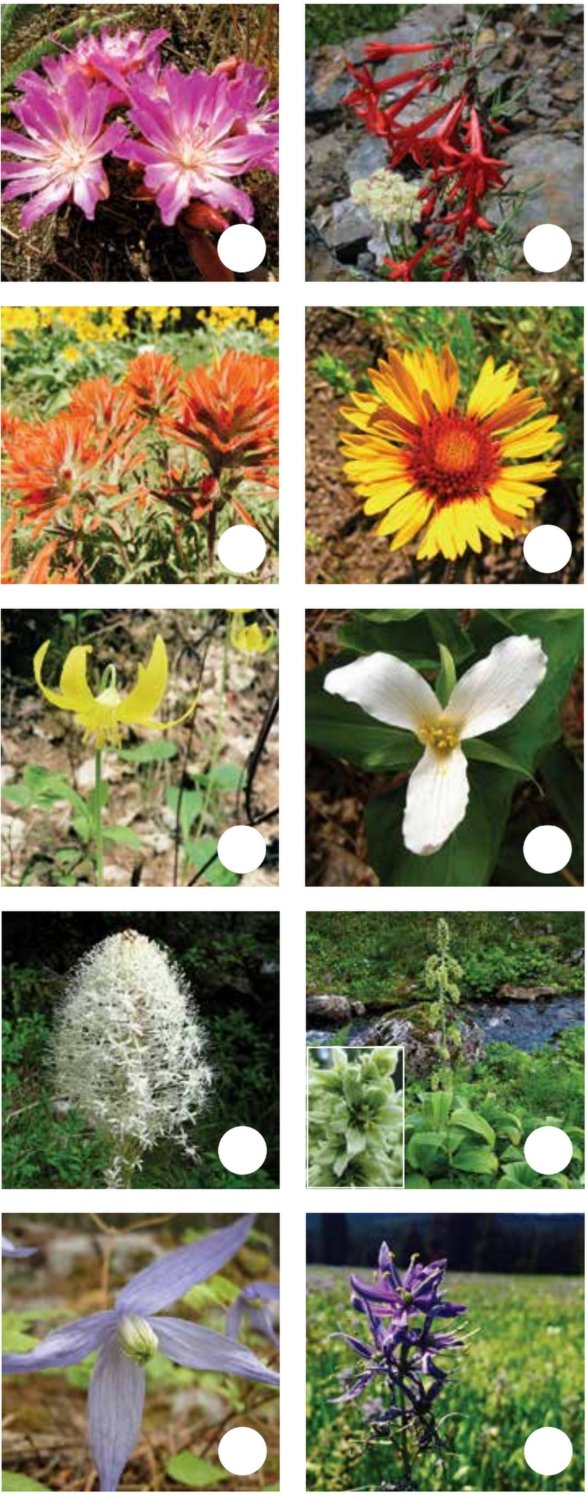by Allison De Jong
Spring and summer is prime wildflower time! How well do you know Montana’s wildflowers? Test your skills with this rainbow assortment—and then go out and see how many you can find. We’d love to see your photos, too; share them by tagging #mtnaturalhistorycenter or #mnhc on Facebook and Instagram.
 A. Blanketflower – Gaillardia aristata
A. Blanketflower – Gaillardia aristata
A member of the aster (or sunflower) family, blanketflower looks very much like a miniature sunflower, 1-2 feet tall, and is found in dry grasslands and open forests. Fun fact: what look like bright yellow petals on a blanketflower are actually individual flowers, called ray flowers, while the deep red-orange center is also made up of tiny individual flowers, called disk flowers. Look closely the next time you find one!
B. False Hellebore – Veratrum viride
Found in subalpine wet forests and clearings, false hellebore is an easily recognizable plant—it can grow up to six feet tall, and has large, ribbed, oval leaves. The small yellow-green flowers are clustered on tassels that droop from the top of the stem. Up close, you’ll see the star-shaped, six-parted flowers with a dark green center.
C. Clematis – Clematis sp.
This widespread climbing or trailing vine is found in grasslands, along streams, and in open ponderosa pine and Douglas-fir forests. The flowers have no petals; it is the four purply-blue sepals (which are usually green in other plants) that draw the attention, attached to the vine by long stalks.
D. Indian Paintbrush – Castilleja sp.
What look like colorful petals are actually bracts or sepals (specialized leaves), which are red, orangish, or yellow. They form a brush-like cluster—you really could imagine yourself painting with it!—on top of the stems, which can be quite short or up to two feet tall. Look for paintbrush at mid to high elevation, in open forests, grassy slopes, and in disturbed areas.
E. Scarlet Gilia – Ipomopsis aggregata
Scarlet gilia’s flowers are a bright, vivid red, with five petals fused into a long tube. The flowers are clustered along and atop the stem, which is usually 1-3 feet tall. Scarlet gilia is found in open dry forests, grasslands, and on rocky slopes.
F. Camas – Camassia quamash
These gorgeous flowers are so blue that meadows filled with them could almost be mistaken for lakes. The rich bluish-purple, six-petaled flowers bloom at the top of 1-2 foot tall stems, and are found at mid elevation grassy slopes and meadows. Lolo Pass’s Packer Meadow and the Big Hole are great places to wander through fields of camas.
G. Trillium – Trillium ovatum
Think threes! Look for three triangular, deep green leaves topped by three bright white, triangular petals (and if you look close, you’ll see three narrow green sepals beneath the petals, too). Trillium is found in moist or wet woods at low to mid elevation.
H. Bitterroot – Lewisia rediviva
Our state flower is a showy one, and well worth tracking down in dry grasslands and rocky slopes (such as Waterworks Hill in Missoula). The flowers have many petals which are vividly pink with pale centers, and grow low to the ground. By the time the flowers bloom, the leaves are often withered and gone.
I. Beargrass – Xerophyllum tenax
When it’s blooming, beargrass is hard to miss. Found in mid to high elevations in open woods, meadows, and clearings, masses of blooming beargrass look like white globes floating a few feet above the landscape. The long stem (up to four feet tall!) rises up from a clump of wiry, grass-like leaves, and atop this stem is a bulb-like cluster of myriad tiny white flowers.
J. Glacier Lily – Erythronium grandiflorum
These bright golden flowers bloom at the top of slender stems, their petals and sepals curving backward while the yellow stamens hang down. Found in moist mid to high elevation shaded sites and meadows, these lovely, graceful lilies bloom shortly after the snow melts, so look for them at lower elevations in spring and in the high country come summer.

This article was originally published in the Spring/Summer 2017 issue of Montana Naturalist magazine, and may not be reproduced in part or in whole without the written consent of the Montana Natural History Center. ©2017 The Montana Natural History Center.
Click here to read more articles from Montana Naturalist magazine.
Want to learn more about our programs? Sign up for our e-newsletter! You can also become a member and get discounts on our programs as well as free reciprocal admission to 300+ science centers in North America!












